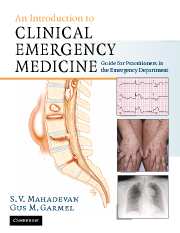Book contents
- Frontmatter
- Contents
- List of contributors
- Foreword
- Acknowledgments
- Dedication
- Section 1 Principles of Emergency Medicine
- 1 Approach to the emergency patient
- 2 Airway management
- 3 Cardiopulmonary and cerebral resuscitation
- 4 Cardiac dysrhythmias
- 5 Shock
- 6 Traumatic injuries
- 7 Prehospital care and emergency medical services
- 8 Pain management
- Section 2 Primary Complaints
- Section 3 Unique Issues in Emergency Medicine
- Section 4 Appendices
- Index
3 - Cardiopulmonary and cerebral resuscitation
Published online by Cambridge University Press: 27 October 2009
- Frontmatter
- Contents
- List of contributors
- Foreword
- Acknowledgments
- Dedication
- Section 1 Principles of Emergency Medicine
- 1 Approach to the emergency patient
- 2 Airway management
- 3 Cardiopulmonary and cerebral resuscitation
- 4 Cardiac dysrhythmias
- 5 Shock
- 6 Traumatic injuries
- 7 Prehospital care and emergency medical services
- 8 Pain management
- Section 2 Primary Complaints
- Section 3 Unique Issues in Emergency Medicine
- Section 4 Appendices
- Index
Summary
Introduction
One of the defining characteristics of emergency physicians is their ability to recognize and manage the undifferentiated patient in cardiac or respiratory arrest. Emergency practitioners must be experts in understanding the pathophysiology of cardiopulmonary arrest and the principles behind the resuscitation of these patients.
Modern cardiopulmonary resuscitation (CPR) began in the late 1950s with the rediscovery of closed chest cardiac massage and mouth-to-mouth ventilation. Advances in external defibrillation and other non-invasive techniques improved success rates of resuscitation and increased the number of individuals who could be adequately trained to immediately provide these interventions. The highest potential survival rate from cardiac arrest can be achieved when there is recognition of early warning signs, activation of the emergency medical system (EMS), rapid initiation of basic CPR, rapid defibrillation and Advanced Cardiovascular Life Support (ACLS), including definitive airway management and intravenous (IV) medications. These steps are known as the “chain of survival.”
While many factors determine survival from cardiac arrest, initiation of early CPR has been scientifically shown to save lives. Data from Seattle demonstrated successful outcome in 27% of patients if ACLS is started within 8 minutes of cardiac arrest. The Journal of the American Medical Association reported that for patients who have CPR started within 4 minutes of arrest and ACLS within 8 minutes, successful resuscitation is increased to 43%.
Pathophysiology
Sudden cardiac death due to unexpected cardiac arrest claims the lives of an estimated 250,000 adult Americans each year. Most of these events will occur outside of the hospital.
- Type
- Chapter
- Information
- An Introduction to Clinical Emergency MedicineGuide for Practitioners in the Emergency Department, pp. 47 - 62Publisher: Cambridge University PressPrint publication year: 2005



